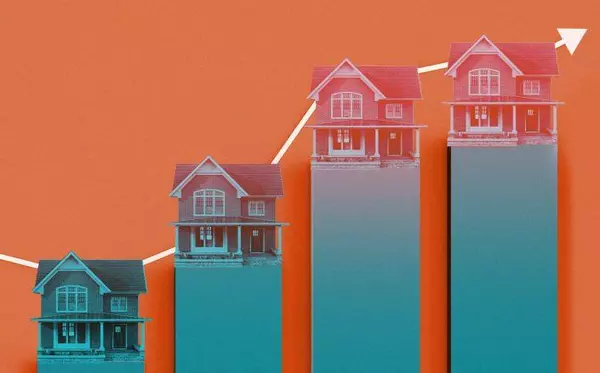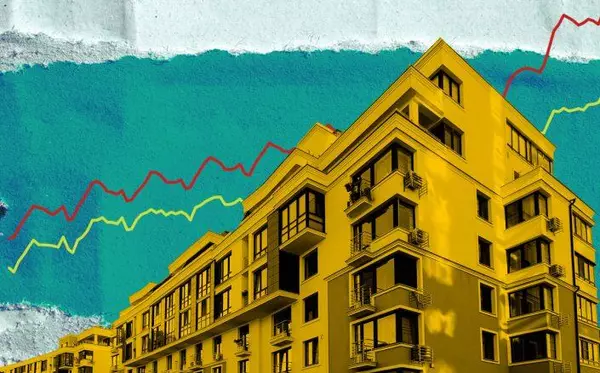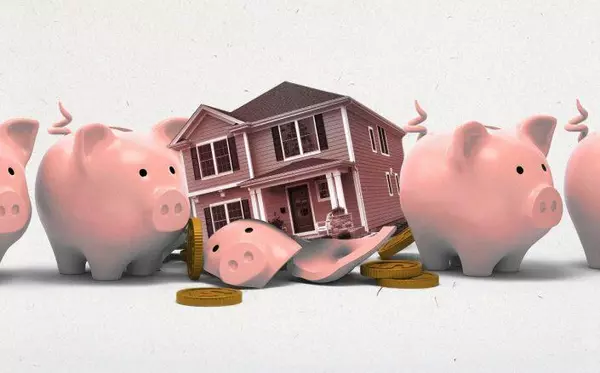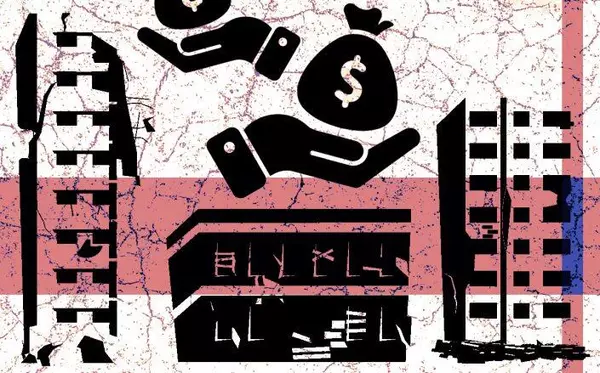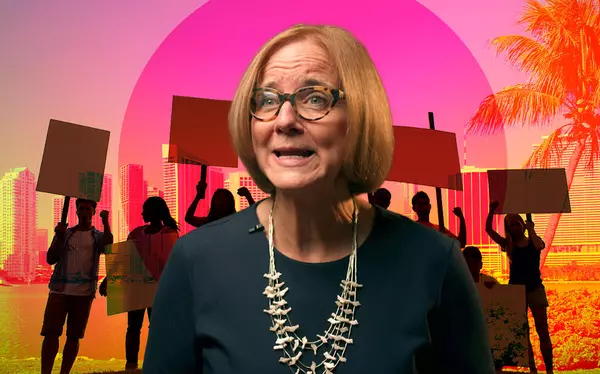
Landlords now required to give 60 days’ notice of rent hikes over 5% in Miami-Dade
Commissioner Eileen Higgins (Eileen Higgins, iStock) Residential landlords in Miami-Dade County are now required to provide tenants with at least 60 days’ notice of rent hikes of 5 percent or more, as renting becomes increasingly more expensive in South Florida. The ordinance, introduced by Commissioner Eileen Higgins, passed unanimously at Tuesday’s commission meeting. Commissioners said property owners have in some cases raised rents by 50 percent or more. It follows similar ordinances in Miami Beach and Hialeah and is countywide. “Thank you all for your understanding about how fair notice is the right thing to do, but not all landlords are doing the right thing. So, this requires them, if their mothers didn’t teach them to do the right thing,” Higgins said. “I guess the Board of County Commissioners can help with that.” The ordinance applies to tenants at the end of their leases and in month-to-month leases, who face rent increases of more than 5 percent. It also extends the required notice time for eviction to 60 days from 30 days for month-to-month tenancies, a spokesperson for the commissioner said. If at the end of a longer lease, such as a 12-month lease, a tenant stays on a month-to-month basis, this new rule would apply. Yet, experts say landlords can skirt the ordinance. Commissioner Keon Hardemon pointed out that landlords could instead offer weekly leases to bypass the legislation, and board chairman Jose “Pepe” Diaz asked the county attorney what penalties exist for landlords who break the rules. The Miami-Dade ordinance can only be enforced in court, as a legal defense to eviction, the county attorney said. It would give renters more time to find new housing if their landlords do not provide sufficient notice. The housing market in South Florida has become out of reach for many. Property owners, faced with high demand and little to no vacancies, have taken advantage of the market and jacked up rents, and in many cases sold their properties at high prices in record numbers. Read more South Florida multifamily sales hit record $11B in 2021, marking nation’s hottest CRE market: report Feverish demand for South Florida homes leads to over-the-top offers Home sales, prices continue rising across South Florida At the same time, home and condo prices have soared as buyers have taken advantage of low interest rates, and many new-to-market buyers flooded the region, also pushing prices up further. As a result, Miami became the least affordable housing market in the country earlier this year, according to a RealtyHop report released last month. A household in the city of Miami would have to contribute 78.7 percent of its income toward homeownership costs, which is based on a median home price of $589,000 and a projected median household income of $43,401. Attorney David Winker, who represents both tenants and landlords, acknowledged the need for tenant protections, but said that this puts the onus on tenants to use it as a legal defense in a court system that was flooded during the pandemic. “Our renters are being brutalized right now,” he said. “We’ve got to give people time to find a new place to live.” Winker’s previous clients included the former tenants of the Hamilton on the Bay in Miami. Last year, property owner Aimco, an apartment real estate investment trust, canceled the leases of its tenants as it embarked on major renovations to the property. Tenants were paying below market rent for units that had not been updated in years. Now, the penthouses at the Hamilton are asking about $21,000 a month, and most units are asking more than $4,000 a month, according to its website. “Landlords see the money, and they have to get rid of tenants. I’m worried it’s going to impact more the mom-and-pop landlords than the national companies,” Winker said. “In reviewing the legislation, there are definitely ways around it. Through private contract, you can avoid this.” The post Landlords now required to give 60 days’ notice of rent hikes over 5% in Miami-Dade appeared first on The Real Deal South Florida.

South Dade boom: D.R. Horton wants to build townhouses in Homestead, another developer proposes apartments in Naranja
(CFM Architects, Octavio A. Santurio Architect) Two developers are proposing new housing projects in south Miami-Dade County, showing the area has caught the eye of builders amid high demand linked to population growth. Major homebuilder D.R. Horton, based in Arlington, Texas, wants to build a 67-townhouse complex in Homestead, and D.E.V. & Associates proposes a 202-unit multifamily building in the Naranja neighborhood in unincorporated south Miami-Dade, according to preliminary applications submitted to the county. D.R. Horton, whose chairman is Donald Horton and president and CEO is David Auld, is under contract to buy 6.5 acres of land it wants to develop from Southwest Sixth Street south to Lucy Street, and from Southwest 14th Avenue east almost up to 12th Avenue, according to its letter of intent. The application does not list the purchase price. The current owner is Lucy Street 328 LLC, managed by Alicio Piña based in Miami Lakes, which paid $257,000 for the land in 2012, property records show. North of that site, D.E.V. & Associates proposes a nine-story Palm at Parker apartment building with a clubhouse, pool and cabanas on 3.2 contiguous acres at 14201 and 14281 Henderson Street, and 14241 and 14259 Henderson Drive, according to its county filings. The property includes a next-door 0.2-acre lot without an address. Records show the owners of the parcels are A Villas Legacy LLC, Dan Nico Properties LLC and Brian Herbert, who paid almost $1.7 million combined for the real estate last year and this year. Three of the parcels currently have single-family homes. D.E.V. & Associates is a real estate developer and contractor based in Miami, said Jorge Vera, who represents the company, adding that D.E.V. does not yet have the property under contract. D.R. Horton and D.E.V. & Associates are requesting a pre-application meeting with county staff members from various departments, who will review the plans for consistency with stormwater, traffic, environmental and other regulations. This is the first submission in the project approval process, with site plan reviews expected next. The proposals are the latest for south Miami-Dade, as the long under-developed area appears poised for more projects amid high residential demand created by a growing population and lack of developable sites in areas closer to the city of Miami. In Homestead, homebuilder Lennar paid $22.5 million for 25.3 developable acres in January, and $7.1 million for another 27 acres in September. D.R. Horton started building homes in 1978 and has a portfolio spanning 44 U.S. markets, according to its website. https://therealdeal.com/miami/tag/dr-horton/ It also has focused on south Miami-Dade, specifically Florida City, where it has developed and purchased land, including paying $6.2 million for property in 2020. The post South Dade boom: D.R. Horton wants to build townhouses in Homestead, another developer proposes apartments in Naranja appeared first on The Real Deal South Florida.

Wall Street bonuses are booming, transforming the luxury market
(Illustration by Paul Dilakian/The Real Deal) Stan Ponte sat across the kitchen table from two Upper East Siders preparing to join the empty nest club in style. The three sipped wine as the couple told Ponte, a Sothebys International Realty veteran, the history of their home. Years earlier, they'd expanded into a neighboring apartment, creating space for a playroom. Their terrace was a treasured outdoor retreat for them and their two dogs. Now that their kids were moving out, the couple was thinking of flying the coop themselves or remodeling. Either way, they were ready for something big. And one factor was driving that. With Wall Street profits and compensation packages soaring to their highest level in a decade, the couple was expecting a major bonus. They could expand again or join the wave of middle-aged buyers Ponte has seen ditching the Uppers and the burbs for more happening digs Downtown. “That’s a $20 million dream,” Ponte said. “But if you’re one of the individuals receiving one of these bonuses, that dream is a reality.” Wall Street’s top six banks made $192.8 billion before taxes last year, more than double the $95.3 billion they earned in 2020, according to the New York state comptroller’s office. Pay at those firms rose almost 12 percent while staffing levels increased just 1 percent. Bonuses, which routinely exceed 100 percent of bankers’ salaries, probably rose by 15 percent or more from last year, according to Alan Johnson of Johnson Associates, a compensation consultancy. In certain areas, like mergers and acquisitions, Johnson estimated bonuses could be up as much as 50 percent. Meanwhile, stock options from prior compensation packages vested far higher than their value when they were awarded, thanks to the bull year. “A perfect storm of wonderfulness, in terms of compensation,” Johnson said. While pay climbs to new heights, financial firms are battling for talent. According to an MIT study, the finance sector’s churn rate hit 10 percent last year. Goldman Sachs lost 15 of every 100 workers. Jolie on Greenwich As they juggle big profits and a flightier talent pool, banks are raining bonuses on employees in numbers unseen since the Great Recession. Many of the beneficiaries are putting that cash into real estate. They want bigger. Taller. More natural light. A second home, or a third or fourth. Duplexes, triplexes. Investment properties and dream homes. A happening neighborhood, a good night’s sleep 60 stories up. Now they’ve got the cash to make it happen. Boatloads of money Wall Street bonuses aren’t single-handedly driving the luxury housing market. But they have spurred an already wealthy buyer pool to pull the trigger on an upgrade or flex in a bidding war. “The data suggest bonuses are just one variable in a complex equation,” said John Walkup, co-founder of UrbanDigs, a real estate data firm. Looking at historical bonus and sale price data, Walkup found no indication that bonuses significantly drive up home prices. Banker upgrades to homes and apartments are taking place in one of the hottest housing markets on record. In the first five weeks of the year, 119 New York homes have sold for $5 million or more, according to data from Serhant. That’s roughly double the total from the same period in 2019, and the second-strongest start in a decade. The median price for the homes was $8 million, the highest on record. “There’s so little inventory that people are doing anything they can to win the bid. Waiving inspections, paying cash, closing late, closing early,” said Christine Poppy, a Compass agent in Connecticut’s Fairfield County, which includes Wall Street bastions Darien and Westport. Money is coming from every direction, not just the financial sector. Crypto billionaires are warping the highest echelons of the market, while tech companies and venture capital firms fan out across the country, allowing workers to settle in high-priced cities not in the Bay Area. “In the past, Wall Street led the charge for very wealthy purchases. Now you have all sorts of different people with boatloads of money,” said Poppy. The ballooning of bonuses, diversity of buyers and dearth of product has finally put developers back in the driver’s seat after a years-long glut of new, luxury apartments. Not only has the market more than recovered from pandemic discounts, but developers see the higher prices enduring. “It’s been consistently crazy busy long enough,” said Noble Black, a Douglas Elliman agent who also advises developers on new condo sales. “Developers are very emboldened in a way that they certainly were not two years ago.” In one recent sponsor-unit sale, Black brought in a buyer whose offer well exceeded the developer’s minimum price. To the agent’s surprise, the developer demanded the buyer cover more of the closing costs. The deal fell through. No city is as popular with bankers as New York. Half of the city’s residents worth $30 million or more work in finance, compared to 39 percent in London and 38 percent in Hong Kong, according to research firm Wealth-X. More than 180,000 New Yorkers have $5 million or more in assets. And they all need a place (or two) to live. Trading up Luxury real estate agents love spring. High-end sales almost always peak as New York’s weather starts to warm, according to data from Olshan Realty. The trend holds in many markets around the country, as families time their moves to be settled in for the next school year. But in New York, bonuses hit bank accounts in the spring as well, driving buying to yearly heights. “Year after year, Wall Street bonuses kick the market into full gear,” said Dan Cordeiro, a broker at Corcoran Sunshine Marketing Group. After stocks climbed to all-time highs last year, “it’s no coincidence that 2021 was the best year in New York City real estate ever.” Even as the market reels from Russia’s invasion of Ukraine, Cordeiro and other luxury agents in New York are watching Wall Street put the fruits of last year’s labor into real estate. At 15 and 35 Hudson Yards, where Succession’s Kendall Roy plots hostile takeovers from his 90th-floor penthouse, Cordeiro sold two three-bedroom apartments to people who lived in smaller units in the same building. “Two years and two bonus cycles later, they want to stay in the building and upgrade,” Cordeiro said. In the past 60 days, he reported three sales over $9 million to finance types who had been renting. In Chelsea, Cordeiro recently sold two three-bedroom apartments to bankers for about $7 million apiece in Lantern House, Related’s luxury condos with bug-eyed windows overlooking the High Line. Serhant agent Krista Nickols recently sold an apartment Downtown to a couple who lived in the neighborhood and had been eyeing their new building for some time. “The only thing that changed was it was January — comp season,” Nickols said. “So they bought.” The bonus gave them the ability to buy immediately. Other potential buyers visited in the fall and wavered. 130 William For many buyers, this year’s big bonuses were their second in two years. Upgrading apartments on just one outsized check could cause problems because the higher housing expenses are recurring. This second bonus truly puts real estate in play, although buyers don’t necessarily say it. “It’s not like my client called me and said I just got a huge bonus; let’s up it,” said Lauren Muss, an agent at Douglas Elliman. “You just know that’s why. Bonuses have not been this big in a long time.” A family affair This year’s bonuses leave many of their younger recipients anxious to spend like their predecessors. Some need a hand. Kirk Rundhaug, an agent at Compass, recently sold an apartment on West 21st Street to a 30-year-old banker for $15 million. The buyer brought his mother to the showing. “Parents are buying apartments for their kids, or the kids are making so much money the parents are trying to guide them,” he said. Rundhaug has fielded particular interest in One Wall Street, Macklowe Properties’ 1.1-million-square-foot condo development just across New Street from the New York Stock Exchange. Newly liquid buyers include full-time residents and commuters, liberated from a five-day workweek who are seeking pieds-à-terre for the days they actually need to come into the office. Older finance workers are using bonuses to keep the family close, but not cramped, in what Compass agent Brian Milton calls “grandparent compounds.” Milton has sold these hulking properties, some 10,000 to 15,000 square feet, across Westchester County and Greenwich, Connecticut. Kobi Lahav, a broker at Living NY, is working with one first-time buyer with a $7 million budget. He’s been renting for years, but now, as a young, single man who suddenly has money to spare, he’s looking for a place he can grow into. “He wants a show-off apartment,” Lahav said. Just a few years ago, Lahav sold a Wall Street trader a $2 million apartment. Since then, the trader has had a kid and is thinking about another. Now that he has his bonus, he wants to upgrade to a loft worth between $5 million and $6 million, and is in no rush to sell the current place. He can always rent it, or stay in it and do extensive renovations on the new one. Buyers’ mentality toward homebuying mirrors their approach to trading securities at work. “You don’t want to buy Amazon when it’s 30 percent up,” Lahav said. “You want to buy it when it’s 20 percent down.” That mentality has led some Wall Streeters to buy in neighborhoods that previous bank bigwigs would never have stepped a Gucci loafer in. “They’re not just jumping into Soho or the West Village,” says Lahav, who recalled a buyer telling him, “I heard there’s some value in Brooklyn.” The city’s seven priciest neighborhoods to buy a home are in Manhattan, according to data from PropertyShark. Brooklyn locales grabbed two of the top 10 spots as prices in Dumbo and Red Hook jumped by about 20 percent last year. The frenzy has even stretched up to Litchfield County, Connecticut, where Compass broker Rich Distel has noticed an increase in finance workers looking to buy. He estimates that four-fifths of his buyers are New Yorkers seeking second homes, and says the heightened demand has spread inventory wafer-thin. He just listed a four-bedroom colonial homestead in Roxbury, Connecticut, for $5.7 million. The property, made of antique woods and local granite, sits on 450 acres of nature preserve. It’s the type of oasis from the city that Wall Streeters have long sought in the Hamptons and Aspen, but it’s a more reasonable schlep from the city. “Normally we wouldn’t see too much activity this time of year, but we are showing it regularly and I don’t expect it to be around for long,” Distel said. Buyers from the financial services industry have also flocked to South Florida, spending millions of dollars on homes and intensifying competition as part of a bigger group of out-of-state buyers. Say what you want about working from home, though: Wall Street isn’t moving anywhere. “Despite the refugees to Florida, all the people screaming about the taxes, complaining about homelessness,” Olshan said. “Get over it — it’s the greatest city in the world. If you evacuate, there’ll be two people behind you wanting your spot.” Katherine Kallergis contributed reporting. The post Wall Street bonuses are booming, transforming the luxury market appeared first on The Real Deal South Florida.
Categories
Recent Posts

